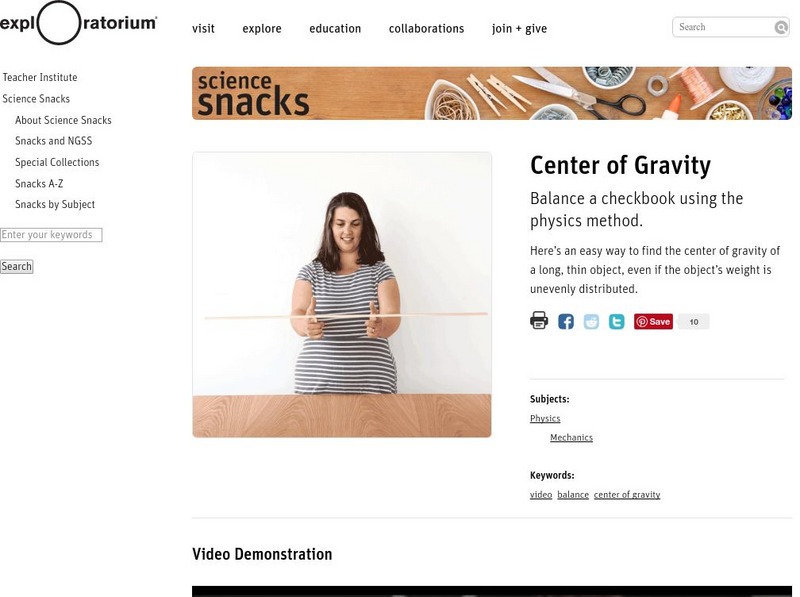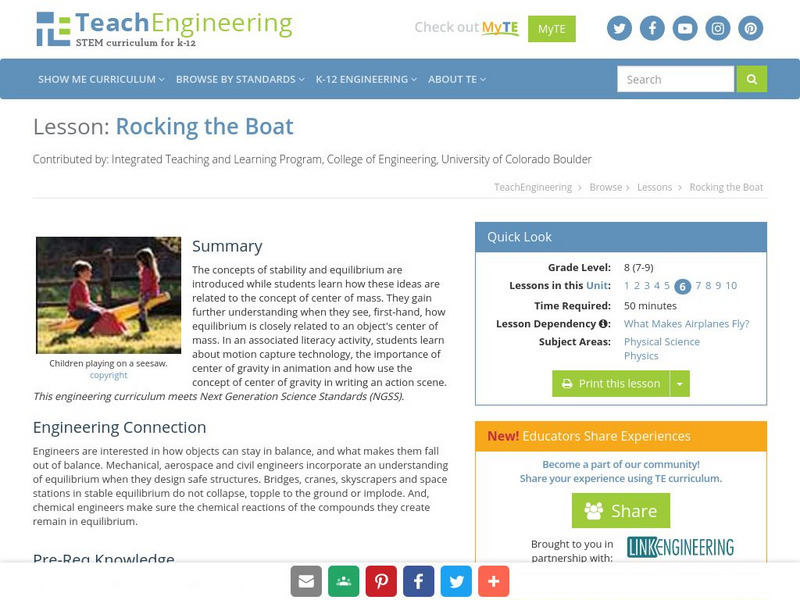Hi, what do you want to do?
Curated OER
Milky Way Galaxy
Students simulate stars in the Milky Way Galaxy using newspaper prints. In this space science lesson, students compare the number of 'stars' on their page to familiar things. They calculate how many pages they need to have the same...
Curated OER
How Fast Is that Rocket?
Eighth graders calculate the speed of a falling object using measurements from a falling rocket. They report data from their data sheet to the teacher to record on the board or on the overhead transparency and discuss the results with...
Curated OER
Water Quality Monitoring
Students comprehend the four parameters of water quality. They perform tests for salinity, dissolved oxygen, pH and clarity or turbidity. Students comprehend why scientists and environmental managers monitor water uality and aquatic...
Curated OER
Simple Harmonic Motion
Students explain the theory of simple harmonic motion (SHM) by performing hands-on, practical application experiments.
Curated OER
Simple Harmonic Motion
Students study harmonic motion and its oscillation. In this simple harmonic motion lesson students demonstrate a series of regular oscillations and explain the theory behind the experiment.
Curated OER
How Can a Spacecraft Always Face the Sun?
Students determine the correct orbital path for a satellite that collects data about the sun so that its view of the sun never be obstructed by the Earth.
Curated OER
Circuit Diagrams: Switching Circuits
Use a lab sheet on circuit diagrams in your electricity unit. Fifth graders draw two series circuits with diagrams, based on two examples. A science experiment prompts learners to use 3x5 cards to illustrate the way a series circuit works.
Curated OER
We Tumble Together
Third graders follow a rubric to create a gymnastic tumbling routine set to music. They videotape and review their performances.
Curated OER
Exploring the Night Sky: Summer
Students explain how moon phases occur. They describe and explain at least two common misconceptions that people have about the moon. Students explain what a star is. They explain 3 ways that the night sky has been used throughout history.
Curated OER
WHAT HOLDS US TO EARTH?
Middle schoolers they imagine they are Galileo and try to duplicate Galileo's experiments and results.
Curated OER
Parachutes And Parafoils
Students study deceleration devices like parachutes and parafoils.
Exploratorium
Exploratorium: Science Snacks: Center of Gravity
This activity demonstrates an easy way to find the center of gravity of an object.
Science Education Resource Center at Carleton College
Serc: Investigating Calculating the Effect of Mass, Length and Displacement
In this physics lab activity students investigate how mass, length and angular displacement affect the period of a simple pendulum. Students control variables, testing one variable at a time, using manual techniques (stopwatch, human...
Science and Mathematics Initiative for Learning Enhancement (SMILE)
Smile: Center of Gravity Lab
This Illinois Institute of Technologysite provides a lab activity in which students find the center of gravity of a box which has nonuniform weight distribution. Complete with directions and discussion questions; answers provided.
PBS
Pbs Kids: Dragonfly Tv: Do It: Balancing Act
An experiment kids can do at home to discover how the center of gravity can affect whether things will balance or not.
PBS
Pbs Teachers: Secrets of Lost Empires I: Stonehenge
Investigate center of gravity by changing the weight distribution of a suspended object.
TeachEngineering
Teach Engineering: Wow! That Captures It!
Students learn how motion capture (mo-cap) technology enables computer animators to create realistic effects. They learn the importance of center of gravity in animation and how to use the concept of center of gravity in writing an...
Science and Mathematics Initiative for Learning Enhancement (SMILE)
Smile: The Center of Mass
This site from the Illinois Institute of Technology provides a lab activity in which students determine the location of the center of mass of an irregularly shaped object. Observations are related to the balancing point of the object....
TeachEngineering
Teach Engineering: Rocking the Boat
The concepts of stability and equilibrium are introduced while students learn how these ideas are related to the concept of center of mass. They gain further understanding when they see, first-hand, how equilibrium is closely related to...
Exploratorium
Exploratorium: Science Snacks: Balancing Stick
An activity to study how the position of the center of gravity is affected by the distribution of mass of an object. This activity ask students to balance a dowel on their finger and by moving the playdoh around the dowel they see how it...
Exploratorium
Exploratorium: Science Snacks: Physics/mechanics (Force and Motion)
A collection of mechanics activities. Many pertain to Newton's laws of motion. Step-by-step directions provided with illustrations. Great for teacher demos or student projects.
TeachEngineering
Teach Engineering: Tightrope Trials
To learn about the concept of center of mass, students examine how objects balance. They make symmetrical cut-outs of different "creatures" and experiment with how they balance on a tightrope of string. Students see the concept of center...
PBS
Pbs Learning Media: Centripetal Force: Pulling Cs and Gs
In this interactive activity from NOVA, discover how centripetal force can affect you when riding in a car or flying at high speeds in a fighter jet.
TeachEngineering
Teach Engineering: Car Collision Testing & Tradeoffs: Don't Crack Humpty
Student groups are provided with a generic car base on which to design a device/enclosure to protect an egg as it rolls down a ramp at increasing slopes. During this activity, student teams design, build and test their prototype...




























